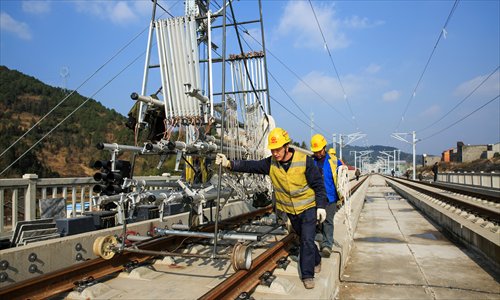No repeat of 2008 stimulus: NDRC
Fiscal spending not to be raised on key projects

A railway construction site in the Qiandongnan Miao and Dong Autonomous Prefecture, Southwest China's Guizhou Province Photo: CFP
China will not raise fiscal expenditure on key projects to shore up economic growth, an official with the country's top economic planner said Thursday.
The country is promoting investment projects in seven key areas, but this is fundamentally different from the 4 trillion yuan ($643.71 billion) stimulus package unveiled in 2008, Luo Guosan, deputy director of the investment department of the National Development and Reform Commission (NDRC), told a press conference on Thursday.
Some of the investment in the projects will come from private capital, and it is not a form of stimulus, Luo said, noting that this is the key policy direction.
China has approved a broader 400-venture, 10 trillion yuan plan running from late 2014 through 2016, and 300 infrastructure projects worth 7 trillion yuan will be started this year, Bloomberg reported Tuesday citing an unnamed source.
Construction of some projects has already started, and some projects are in the preliminary preparation stage, so it is difficult to specify the total amount of investment, Luo said.
The NDRC said in December that the country is pushing ahead with investment projects in seven key areas, including information networks, health, elderly care, clean energy, transportation and oil. But the commission did not specify the amount of investment involved.
China unveiled a major 4 trillion yuan stimulus plan in 2008 in order to shore up the country's economy against the effects of the global financial crisis.
However, there has been criticism since then about the side-effects of the plan, such as industrial overcapacity and the rising level of local government debt.
"The main purpose of the stimulus package in 2008 was to stimulate the economy with numerous projects. Monetary policy was also loose back then," Tang Jianwei, a senior macroeconomic analyst at Bank of Communications, told the Global Times Thursday.
But now the projects are focused on improving people's livelihoods and on necessary infrastructure projects, especially those in the central and western regions, as part of efforts to implement the country's "One Belt and One Road" strategy, Tang said.
The "One Belt and One Road" strategy, which refers to the Silk Road Economic Belt and the 21st Century Maritime Silk Road, was proposed by President Xi Jinping late in 2013.
It was designed to strengthen the infrastructure as well as economic and trade ties with countries and regions along the Silk Road Economic Belt and the 21st Century Maritime Silk Road.
"We believe that the government has learned its lessons, and is unlikely to repeat the same program it had during the global financial crisis," Liu Ligang, chief economist at Australia and New Zealand Banking Group, said in a research note e-mailed to the Global Times Thursday, adding that China is still experiencing a de-leveraging process and many traditional sectors are struggling with overcapacity.
"The seven strategic investment industries are in line with China's 'new normal economy' framework, focusing on services, high-end equipment manufacturing and advanced technology," Liu said.
Economic growth slipped to 7.3 percent in the third quarter from a year earlier. And December's weak manufacturing figures suggested that annual growth may not hit the 7.5 percent target for 2014.
China's top leaders have said on various occasions that the country needs to adapt to a "new normal" agenda in its pace of economic growth and avoid using aggressive stimulus.
Encouraging private capital to invest in the key projects means the sources of funding will be more diversified, reducing the possibility of systemic risks, Tang said.